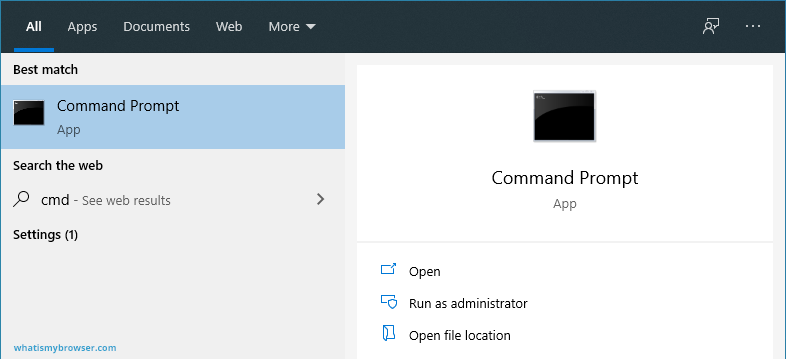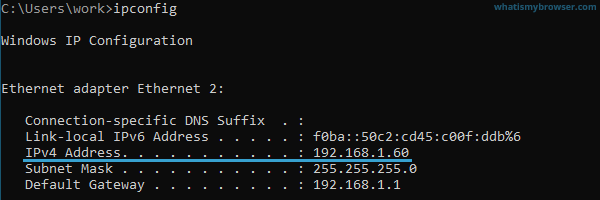What is my local IP Address?
-
Mục Lục
Search for the Command Prompt tool
In the bottom-left corner of your Windows desktop, you will see an input box which says Type here to search. Windows will search your whole system for anything you type in there.
We want to open a command prompt, so search for the command prompt by typing in Command Prompt

Note that you can also search for the abbreviation: cmd
-
Press the Enter key to run the Command Prompt tool
Now that you’ve searched for the Command Prompt, Windows has found it and has highlighted as the main search result.

Simply press the Enter key on your keyboard to run the Command Prompt tool. Alternatively you can double click the icon.
If Windows Search hasn’t found the Command Prompt, make sure that you’ve typed Command Prompt properly – remember you can also search for the abbreviation: cmd. Also make sure that the All tab is selected at the top of the Search window (and not “Documents” or “Web” etc).
-
You’ll see a fresh Command Prompt window appear
Now that you have selected the Command Prompt from the Windows Search, you’ll now see a fresh Command Prompt window. It’s possible to type lots of different commands into it to get Windows to perform certain tasks or show you various information.

-
Use the ipconfig command
Now that you have a Command Prompt open, simply type the command ipconfig into it and then press the Enter key. The Internet Protocol Configuration tool will now run and show you some information about your local network connection.
-
Look for your local IP Address Number
The ipconfig tool will have printed a number of things on the command prompt, it will look something like this screenshot:

We have underlined the line which says IPv4 Address, you can see the IP Address (in this example, it begins with 192.168…) in the right-hand column.
If you have more than one local network connection (perhaps you have two network cards, or perhaps you are connected by WiFi and a network cable) you may have more than one network adaptor; you will need to look for the IPv4 Address line under each adaptor section of the read-out.
-
Click the Apple Menu icon
In the top-left corner of your Mac screen, click the small Apple icon. It will expand a list of System options.

-
Click the “System Preferences” item

-
Click the “Network” icon
The System Preferences window will have a number of icons which let you view and control various settings for your Mac. Near the middle you will see the “Network” icon as shown in the screenshot. Click on it to open your Network settings.

-
Look for your local IP Address Number
System Preferences will show you a list of your network adaptors up the side of the Network window; it will put the connected interfaces at the top (and highlight them with a Green dot).

If you only have one connected network adaptor (as shown in the screenshot above), you simply need to look to the right of the Network window: macOS will show you what your local IP Address is and how you are connected to your local network.
If you have more than one network adaptor, you will probably also have more than one local IP address. This can happen if you are using a laptop with WiFi but also have it plugged in to a network cable or Thunderbolt or USB network adaptor. If you do have more than one network adaptor, you can click on each one in the left-hand section of the Network window and look over on the right-hand side of the window to read each local IP address.
JavaScript needs to be enabled in order to detect your local IP address.
Unfortunately most web browsers now prevent websites from automatically detecting what your local IP Address is, so we can’t detect it for you. Instead, here are the steps you need to take to find your local IP address.
The easiest and quickest way to find your local IP address on a Windows 10 computer is to type a special command into the command prompt. These instructions will clearly show you how to do this.
Find local IP Address on macOS
To find your local IP Address on macOS you need to look at your Network Settings. Here is how to easily find your network details.
How did we (used to) detect local IP Addresses?
One of the new additions to some modern browsers is WebRTC.
WebRTC is an API which is geared at enabling real-time in-browser communications without the need for extra plugins – for things like in-browser video chat without the need for extra plugins. It holds a lot of potential for the future of online communication and is an exciting development.
For a while, it was possible to get the WebRTC API in some web browsers to reveal what your local IP address/s were. Most web browser manufacturers have now blocked web browsers from finding this information, as it can also lead to a loss of your privacy online. As a result, we’re not able to easily show you what your local IP address is to help you with your troubleshooting; instead you need to go thorugh your computer’s network settings and find it yourself.
It is still actually possible for web browsers to provide this type of detection, however it is disabled by default (and probably shouldn’t be enabled).
More questions?
If you have any more questions, use the contact form and we’ll answer it and add your question here.















![Toni Kroos là ai? [ sự thật về tiểu sử đầy đủ Toni Kroos ]](https://evbn.org/wp-content/uploads/New-Project-6635-1671934592.jpg)


